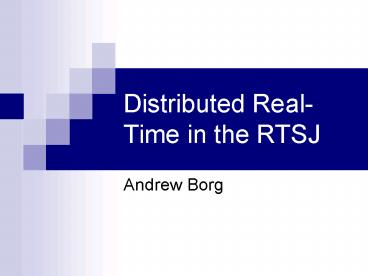Distributed Real-Time in the RTSJ - PowerPoint PPT Presentation
1 / 38
Title:
Distributed Real-Time in the RTSJ
Description:
RMI A brief introduction. The RTSJ A (very) brief introduction ... RMI A brief introduction. The RTSJ A brief introduction. The DRTSJ Current Status ... – PowerPoint PPT presentation
Number of Views:60
Avg rating:3.0/5.0
Title: Distributed Real-Time in the RTSJ
1
Distributed Real-Time in the RTSJ
- Andrew Borg
2
Presentation
- RMI A brief introduction
- The RTSJ A (very) brief introduction
- The DRTSJ The 3 Levels of Integration
- RMIRTSJ Concerns, Issues and Solutions
3
Presentation
- RMI A brief introduction
- The RTSJ A brief introduction
- The DRTSJ Current Status
- RMIRTSJ Concerns, Issues and Solutions
4
The RMI Specification
- RMI is very minimal.
- Assumes a homogeneous environment of JVMs.
- There is no ORB concept (see later)
5
Goals
- Support seamless remote invocation on objects.
- Retain most of the Java language's object
semantics. - Make differences between the distributed object
model and local Java object model apparent. - Make writing reliable distributed applications as
simple as possible. - Preserve the type-safety provided by the Java
runtime environment. - Various reference semantics for remote objects
for example live (nonpersistent) references,
persistent references, and lazy activation. - Enforce the safe Java environment provided by
security managers and class loaders.
6
A simple HelloPerson example
- Client sends name to a server.
- Server returns hello the name passed
7
The interface
- public interface HelloPersonInterface extends
java.rmi.Remote - public void sayHello() throws
java.rmi.RemoteException
8
The Implementation
- public class HelloPerson implements
HelloPersonInterface - public HelloPerson ()
- public String sayHello(String S)
- return new String("Hello World"S)
9
Generate Stub Using rmic
- See later
10
Launching the Server
- Registry r createRegistry(4321)
- HelloPersonImpl x new HelloPersonImpl()
- Remote s UnicastRemoteObject.exportObject(x)
- r.bind("MyHelloServer",s)
11
Invoking the Server
- HelloServerInterface H (HelloServerInterface)
r.lookup("MyHelloServer") - System.out.println(H.sayHello("Andrew"))
12
The RMI Classes
Interface
ServerStub
Server
13
The Stub
- public final class HelloServerImpl_Stub
- extends java.rmi.server.RemoteStub
- implements HelloServerInterface
- public java.lang.String sayHello(java.lang.Str
ing param_String_1) - throws java.rmi.RemoteException
- Object result ref.invoke(this,
method_sayHello_0, new java.lang.Object
param_String_1, 8370655165776887524L) - return ((java.lang.String) result)
14
Distributed vs. Centralised
- Clients of remote objects interact with remote
interfaces - Non-remote arguments to, and results from, an RMI
call are passed by copy. - A remote object is passed by reference, not by
copying the actual remote implementation. - Since the failure modes of invoking remote
objects are inherently more complicated than the
failure modes of invoking local objects, clients
must deal with additional exceptions.
15
(No Transcript)
16
The DGC
- Is part of the specification
- Uses a lease-mechanism with reference counting
- Internally also keeps the VM alive when remote
objects exist
17
JRMP
- Serialization Protocol
- HTTP Protocol
- Output defines sub-protocol
- single-op
- stream
- multiplex
18
Presentation
- RMI A brief introduction
- The RTSJ A brief introduction
- The DRTSJ The 3 Levels of Integration
- RMIRTSJ Concerns, Issues and Solutions
19
The Real Time Specification for Java (RTSJ)
- The 7 enhanced areas over Java
- Thread Scheduling and Dispatching
- Memory Management
- Synchronization and Resource Sharing
- Asynchronous Event Handling
- Asynchronous Transfer of Control
- Asynchronous Thread Termination
- Physical Memory Access
20
JSR 50
- extends RMI in the RTSJ to provide support for
predictability of end-to-end timeliness of
trans-node activities. - Expert group has published a framework for the
implementation of JSR 50, describing three levels
of integration.
21
The 3 levels of Integration
- Level 0 RTSJ RMI
- Level 1 RTSJ Realtime RMI
- Level 2 RTSJ Realtime RMI Distributed
Threads
22
Two Requirements for RT-RMI
- Requirement 1 Real-time Invocation
- End-to-End timeliness in the invocation process
- Requirement 2 Support for RT-RMI
- Serialization, the DGC, etc.
23
Real-time Invocation Control in RT-RMI
RMI in Java
RT-RMI
24
The RMI Classes
25
(No Transcript)
26
Exporting Server Parameters
- Export methods defined in subclass of
RealtimeRemoteServer - public static RealtimeRemoteServer exportObject
- (
- RealtimeRemote obj, int port,
- SchedulingParameters sp, NetworkParams np,
- Threadpool pool
- )
- Realtime-parameters passed up to
RealtimeRemoteServer - Network parameters stay with subclass
27
Propagating Client Parameters
- Assigning parameters to a RealtimeRemoteStub
instance. - Implicitly inheriting or deriving the parameters
from the client Schedulable object. - Explicitly specifying parameters for each
invocation.
28
RT-RMI Server Thread Model
- Single Acceptor Thread associate with each
exported object - Acceptor is most eligible thread if CP
- Accepts call and deserialises RT parameters
- Handler Thread
- Deserialises non RT parameters
- Makes Upcall on Object
- Serialises the result and sends back to the
server - Threadpool of handler Threads
29
(No Transcript)
30
(No Transcript)
31
(No Transcript)
32
Memory Considerations in implementation
- Problems for the application developer
- Parameters exported are used in the Schedulables
created. - RTSJ scoping rules must be respected in the
upcall - Problems for the developer
- Threadpools implementation in not trivial
- Proper scoping should be used to free objects
after invocation
33
The DGC
- If scoped memory removes GC, can it also be used
to solve DGC? - What are the semantics involved?
- In particular, what is a remote object?
34
Connections
- Should be part of a spec?
- Attach connections to pools?
- Can we assume connection-oriented protocols
- RSVP
35
Carrying out distribution
- How would a correct RTSJ be moved to a
distributed environment?
36
Asynchronicity
- What are the semantics of AIEs across node
boundaries? - 2 levels to address
37
CORBA and DRTSJ
- Is RTSJ RTCORBA DRTSJ?
- Must RTCORBA be Java aware?
- How would a mapping work?
38
Conclusion































